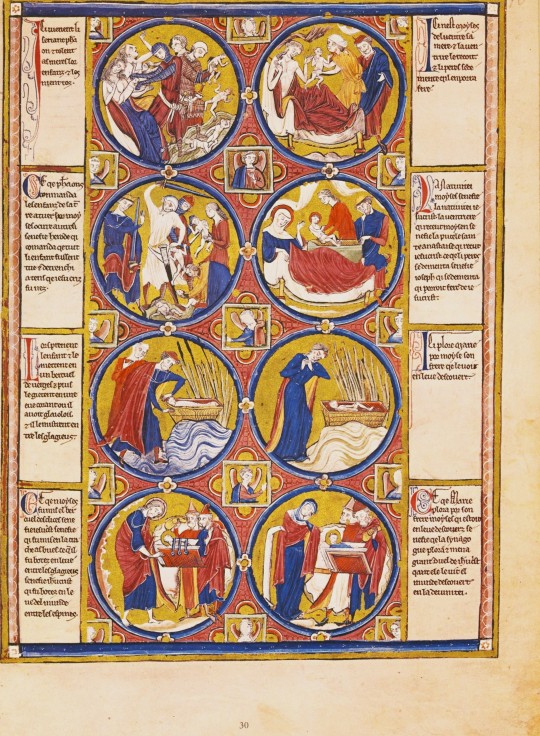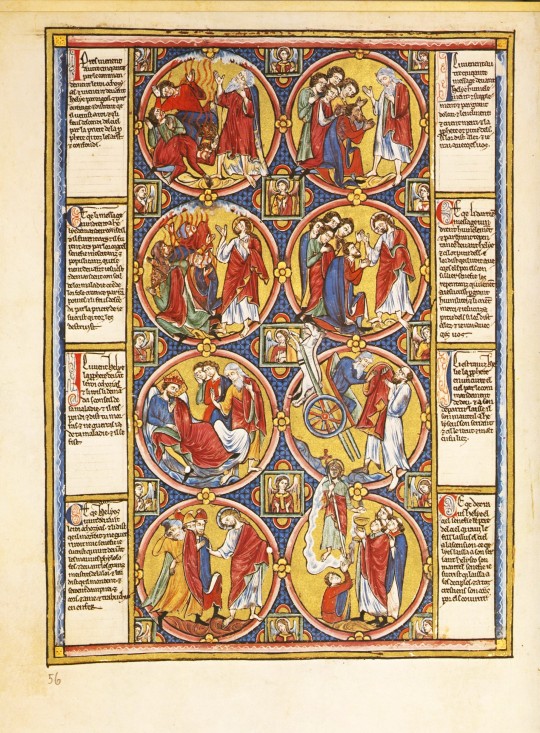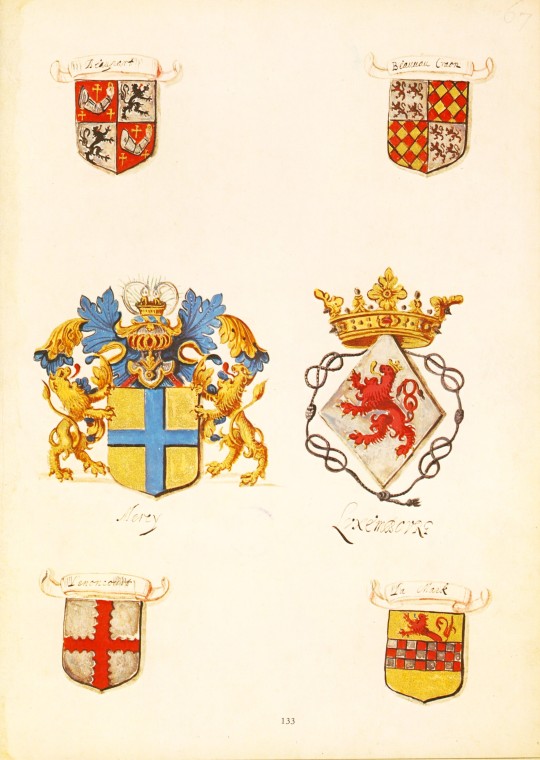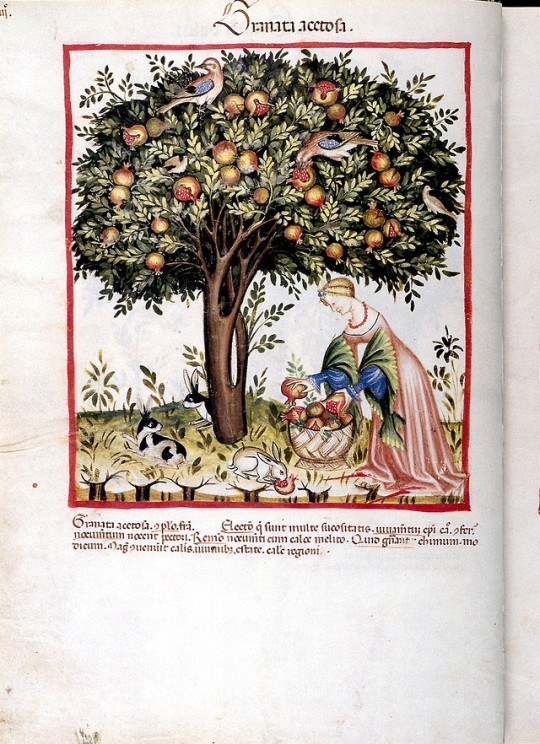#Akademische Druck- u. Verlagsanstalt
Text



Easter Moralized
This Easter (which, btw, in 2024 is also International Transgender Day of Visibility) we explore the gilded pages of the Vienna Bible Moralisée (moralizing bible), of which we hold the first full-color facsimile published in 1973. The Vienna Bible Moralisée is also known as Vienna 2554, referencing its current place of residence at the Austian National Library in Vienna. One of only three 13th-century moralizing bibles still in existence, this manuscript is an excellent example of the of the ways in which Christians worked to simplify the lessons of the Bible for those that were not theological scholars. Even though they were made to be more accessible, these types of manuscripts were only created for the wealthy class; they needed to understand the Christian Bible and its lessons to ensure that they were (theoretically) promoting moral behavior. Vienna 2554 is thought to have been commissioned by Phillip II Augustus, for his son, Louis VIII or his bride, Blanche of Castile.
The Bible Moralisée is curious for two reasons: it does not actually contain the entire text of the Christian Bible, and it is mostly filled with images, rather than with words. These specific attributes contribute to the accessibility of Christian morals by abbreviating biblical stories and using illuminations to visually represent them.


Interestingly, the designs on the pages of these bibles imitate stained glass representations at the time: the eight medallions placed in columns of four; the inclusion of quatrefoils in between these medallions; the use of vivid colors. This reflection of architectural design in the illuminations may have allowed people to visualize themselves in a church and may have led to more contemplative readings of the text that emphasized the teachings of priests and theologians at the time. One of the most well-known images in these types of bibles is Jesus as architect and creator of the universe. This type is seen on the frontispiece of this moralizing bible: Jesus is holding a compass as he focuses on the creation of the world. Geometry and astronomy were often associated with the divine in the Middle Ages and this viewpoint is well explained in Vanderbilt's Divinity Library website: "God has created the universe after geometric and harmonic principles, to seek these principles was therefore to seek and worship God."

The creation of the moralizing bible also inspired later moralizing versions of books and poetry, like Ovid’s Metamorphoses. These types of moralizing volumes edited and changed parts of the works to make them conform to Christian teachings oft the time.
Our facsimile was published in 1973 by the Akademische Druck- u. Verlagsanstalt in Graz, Austria in an edition of 3,000 copies at the manuscript's original size. To see the original manuscript, you can visit the Österreichische Nationalbibliothek in Vienna or view the entirety of the manuscript online on their website here.
View more manuscript posts.
– Sarah S., Special Collections Graduate Intern
#Easter#bible moralisée#vienna bible moralisée#vienna 2554#austrian national library#Österreichische Nationalbibliothek#moralizing bible#bible#Akademische Druck- u. Verlagsanstalt#Christian bible#facsimiles#manuscripts#illuminated manuscripts#medieval manuscripts#Sarah S.#International Transgender Day of Visibility
51 notes
·
View notes
Text

Simon Bening - Da Costa Hours, Office of the Dead, fol. 226v (c. 1515)
Credits:
Image courtesy of Akademische Druck- u. Verlagsanstalt, Graz/Austria.
19 notes
·
View notes
Photo

Pomegranate Tree. Codex Vindobonensis series nova 2644 der Osesterreichischen Nationalbibliothek Graz, Austria: Akademische Druck-u Verlagsanstalt, 1967.
Tacuinum sanitatis in medicina. Credit: Wellcome Collection. CC BY
#Wellcome Collection#Creative Commons#Tacuinum sanitatis in medicina#Tacuinum Sanitatis#Pomegranates#Medieval rabbits#Medieval Medicine
8 notes
·
View notes
Text

Simon Bening - Da Costa Hours, Hours of the Passion, fol. 15v (c. 1515)
Image courtesy of Akademische Druck- u. Verlagsanstalt, Graz/Austria.
10 notes
·
View notes
Photo



Swan Upping 2017: Day 2
Yesterday began the annual census of the Mute Swan population on the River Thames. It’s day two and we will talk a little about the history of the Swan Upping event. Official royal ownership of Mute Swans in England began in the 12th century when any unmarked swan became property of the crown. In the 14th century the office “Keeper of the King’s Swans” came into existence. There were also several private swan owners who employed swan herds to maintain their flocks. Before the young swans, cygnets, were able to fly they were rounded up along with their parents, the cob and pen, and to claim ownership they were given marks on their bills to match those of the parents. To own swans and to serve them up as a ceremonial dish at banquets was a display of status.
Along with the Royal Swan Uppers, there are two other groups that are granted rights to the mute swans on the River Thames, the Worshipful Company of Vintners and the Worshipful Company of Dyers. The original purpose of Swan Upping was to ensure ownership of the swans and a ready supply of meat for the royal and livery company banquets. Today the process is more about conservation and ensuring the health of the Mute Swan population.
The images above are from De Arte Venandi cum Avibus. Ms. Pal. Lat. 1071, Biblioteca Apostolica Vaticana. Facsimile reproduction by Akademische Druck- u. Verlagsanstalt, Graz. Printed in Austria 1969. See our other post featuring this manuscript.

The Royal Swan Uppers, the Vintners, and the Dyers, with their identifying banners, using their skiffs to gather a family of swans.
View all 5 days of Swan Upping.
#swan upping#dyers#vintners#swans#birds#british history#medieval manuscripts#facsimilles#cygnus#livery company#alison
65 notes
·
View notes